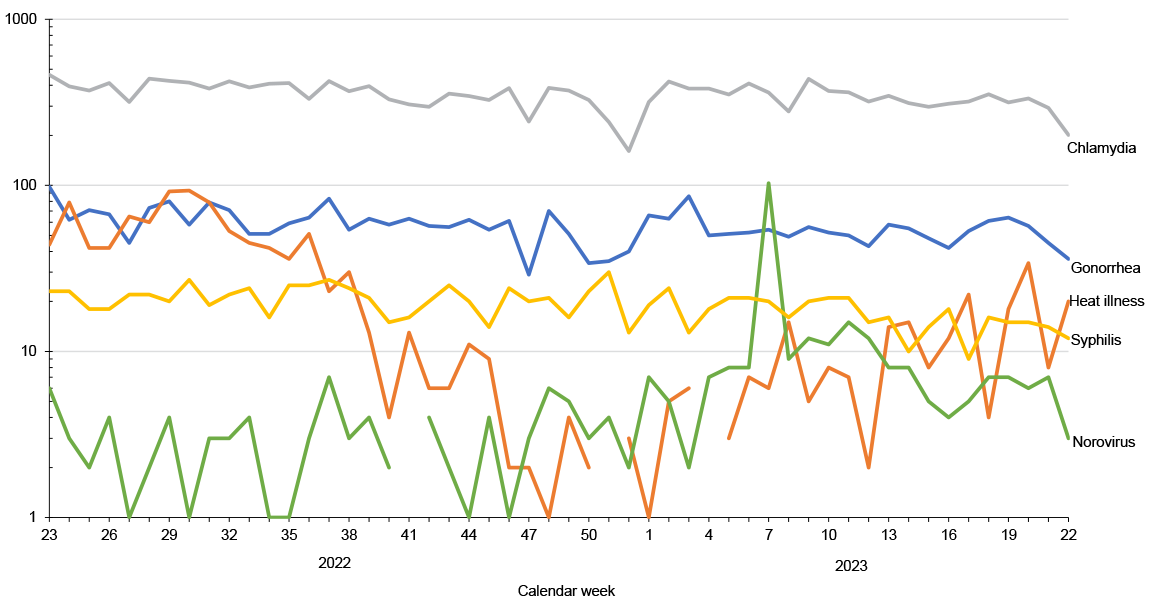Reportable Medical Events, Military Health System Facilities, Week 22, Ending June 3, 2023
 Graph depicting the frequency of the five most common reportable medical events within the Military Health System over the preceding year.
Graph depicting the frequency of the five most common reportable medical events within the Military Health System over the preceding year.
Reportable Medical Events are documented in the Disease Reporting System internet by health care providers and public health officials across the Military Health System for the purpose of monitoring, controlling, and preventing the occurrence and spread of diseases of public health interest or readiness importance. These reports are reviewed by each service’s public health surveillance hub. The DRSi collects reports on over 70 different RMEs, including infectious and non-infectious conditions, outbreak reports, STI risk surveys, and tuberculosis contact investigation reports. A complete list of RMEs is available in the 2022 Armed Forces Reportable Medical Events Guidelines and Case Definitions.1 Data reported in these tables are considered provisional and do not represent conclusive evidence until case reports are fully validated.

Total active component cases reported per week are displayed for the top five RMEs for the previous year. Each month, the graph is updated with the top five RMEs, and is presented with the current month’s (May 2023) top five RMEs, which may differ from previous months. COVID-19 is excluded from these graphs due to changes in reporting/case definition updates in 2023.

References
- Armed Forces Health Surveillance Division. Armed Forces Reportable Medical Events. Accessed April 6, 2023. https://www.health.mil/Military-Health-Topics/Health-Readiness/AFHSD/Reports-and-Publications/Armed-Forces-Reportable-Medical-Events
- Defense Manpower Data Center. Department of Defense Active Duty Military Personnel by Rank/Grade of Service, October 31, 2022. https://dwp.dmdc.osd.mil/dwp/app/dod-data-reports/workforce-reports
- Defense Manpower Data Center. Armed Forces Strength Figures for January 31, 2023. https://dwp.dmdc.osd.mil/dwp/app/dod-data-reports/workforce-reports
- Navy Medicine. Surveillance and Reporting Tools–DRSI: Disease Reporting System Internet. https://www.med.navy.mil/Navy-Marine-Corps-Public-Health-Center/Preventive-Medicine/Program-and-Policy-Support/Disease-Surveillance/DRSI
You also may be interested in...
Report
Oct 1, 2022
 .PDF |
1.41 MB
.PDF |
1.41 MB
A monthly publication of the Armed Forces Health Surveillance Division. This issue of the peer-reviewed journal contains the following articles: Surveillance trends for SARS-CoV-2 and other respiratory pathogens among U.S. Military Health System Beneficiaries, Sept. 27, 2020 – Oct. 2,2021; Establishment of SARS-CoV-2 genomic surveillance within the ...
Article
Oct 1, 2022
This study reports updated numbers and incidence rates of hepatitis C virus (HCV) infection among active component members of the U.S. military using a revised case definition during a 10-year surveillance period between 2011 and 2020.
Article
Oct 1, 2022
Immunization Among U.S. Armed Forces Healthcare Workers
Article
Oct 1, 2022
This report summarizes the annual prevalence of permanent sterilization, as well as use of long- and short-acting reversible contraceptives (LARCs and SARCs, respectively), contraceptive counseling services, and use of emergency contraceptives from 2017 through 2021 among active component U.S. service women.
Report
Sep 23, 2022
 .PDF |
5.01 MB
.PDF |
5.01 MB
This annual report provides a summary of the Armed Forces Health Surveillance Division's accomplishments during 2021.
Report
Sep 1, 2022
 .PDF |
2.12 MB
.PDF |
2.12 MB
A monthly publication of the Armed Forces Health Surveillance Division. This issue of the peer-reviewed journal contains the following articles: Surveillance trends for SARS-CoV-2 and other respiratory pathogens among U.S. Military Health System Beneficiaries, Sept. 27, 2020 – Oct. 2,2021; Establishment of SARS-CoV-2 genomic surveillance within the ...
Article
Sep 1, 2022
Menstrual suppression allows for the control or complete suppression of menstrual periods through hormonal contraceptive methods. In addition to preventing pregnancy, suppression can alleviate medical conditions and symptoms associated with menstruation such as iron deficiency anemia,1 eliminate logistical hygiene-related challenges, and improve ...
Article
Sep 1, 2022
This report provides an update through June 2022 of routine screening results for antibodies to the human immunodeficiency virus (HIV) among members of the active and reserve components of the U.S. Armed Forces. During the full 5 and 1/2-year surveillance period, the HIV seropositivity rates for active component service members were 0.21 positives per ...
Article
Sep 1, 2022
The validity of military hepatitis C virus (HCV) surveillance data is uncertain due to the potential for misclassification introduced when using administrative databases for surveillance purposes. The objectives of this study were to assess the validity of the surveillance case definition used by the Medical Surveillance Monthly Report (MSMR) for HCV ...
Article
Sep 1, 2022
We read with interest the brief report regarding the prevalence of Hepatitis C Virus (HCV) infection in basic military trainee blood donors by Kasper and colleagues in the November 2021 issue of the Medical Surveillance Monthly Report (MSMR),1 an update of a previous similar report
Article
Aug 30, 2022
Comprehensive Airman Fitness is comprised of physical, social, spiritual and mental fitness. Being physically fit to fight and maintaining a war fighter spirit are crucial to completing the mission.
Article
Aug 29, 2022
Scuba diving can be extremely dangerous, and it’s possible for divers to develop adverse medical conditions and injuries while performing underwater operations. A common diving injury is decompression sickness (DCS), also referred to as the “bends”.
Article
Aug 22, 2022
Bulgarian Armed Forces showed off their combat lifesaving training to a U.S. delegation Aug. 10.
Article
Aug 15, 2022
What you should know and do about bee, wasp, and hornet stings
Article
Aug 5, 2022
Mpox is rare. Here’s how to protect yourself and your family and when to contact a medical provider.
You are leaving Health.mil
The appearance of hyperlinks does not constitute endorsement by the Department of Defense of non-U.S. Government sites or the information, products, or services contained therein. Although the Defense Health Agency may or may not use these sites as additional distribution channels for Department of Defense information, it does not exercise editorial control over all of the information that you may find at these locations. Such links are provided consistent with the stated purpose of this website.
You are leaving Health.mil
View the external links disclaimer.
Last Updated: August 24, 2023